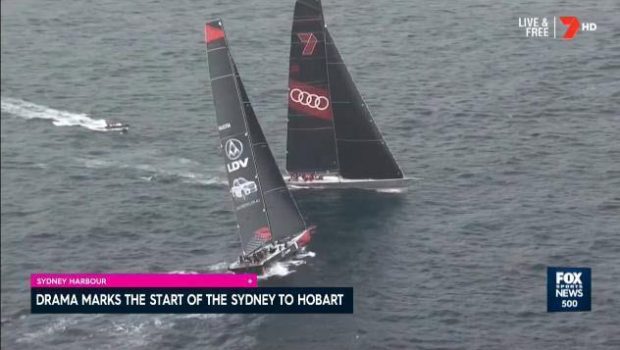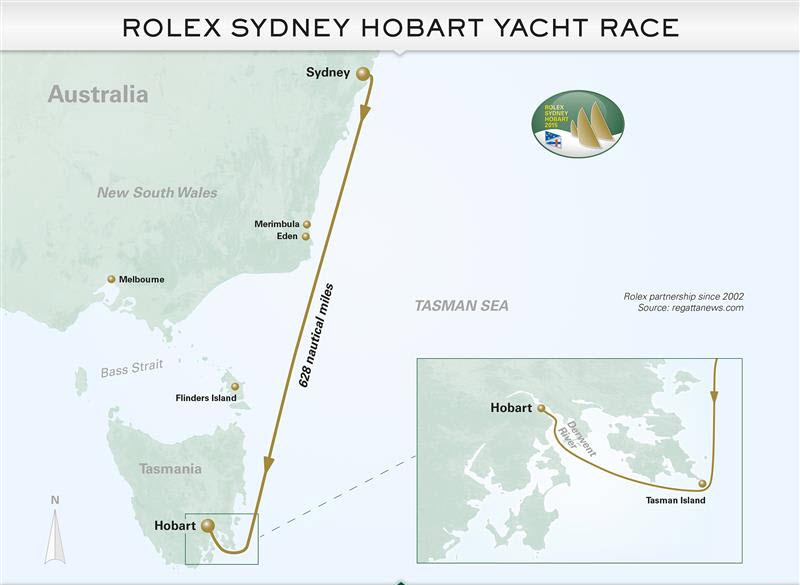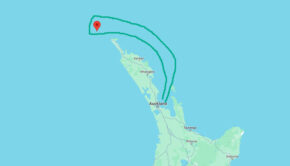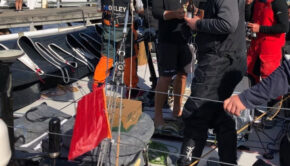Penalties: There must be a better way
Published on January 2nd, 2018
The maxi fleet attracts heaps of attention in the Cruising Yacht Club of Australia’s Rolex Sydney Hobart Yacht Race, and when a foul between two of the goliaths occurred before leaving Sydney Harbour, the ensuing penalty from the hearing in Hobart got the waterfront buzzing with heated debate.
David Salter, who has been doing the 628 nm contest since 1965, reflects on the wider implications of this year’s controversial protest decision after the port/starboard incident between the 100-footers Wild Oats XI and Comanche.
The fair, proportionate and consistent application of penalties continues to be one of the most problematic areas of our sport.
When yacht racing began to organize itself more than 200 years ago the individual clubs made their own rules and resisted a common code. One of the most acrimonious of all protests was reported in the 1850s by Hunt’s Yachting Magazine in the UK and centered on – guess what – a protest over “water to tack”. Sound familiar?
The general format of racing rules and sailing instructions we recognize today weren’t adopted until 1876, and only after the Prince of Wales bashed some heads together at Commodore level and convinced all the “Royal” clubs to adopt an agreed set of rules.
Although the British clubs tended to set the model for the regulation of racing, many of the “when boats meet” principles we still abide by were adapted from a very logical list of standards laid out in the early 1900s by the New York Yacht Club. Of those, the relevant section for us here was:
“A yacht may not tack so as to involve risk of collision with another yacht before filling on her new tack, nor as to involve risk of collision….”
Interestingly, the mechanism of penalties (penalty turns for unintentional fouls) is a relatively modern phenomenon. That concept was not formally recognized until introduced by the International Yacht Racing Union (now World Sailing) in 1973 (sadly, too late to help Gretel II in its infamous 1970 America’s Cup start-line dispute with Intrepid).
But there are problems with penalties when that corrective is taken beyond its originally intended – and narrow – application to one-design and match racing.
What are the relative weights of an on-water infraction as opposed to some technical breach? To what extent should a penalty be punitive as well as an attempt to expunge any advantage the boat at fault may have obtained? Should penalties be primarily a system to restore fairness in the final results, or should they act more as deterrents to discourage careless or unscrupulous racing?
Our interest here is not so much in the rights or wrongs of the specific incident involving Wild Oats XI and Comanche. There is no doubt from the video evidence that Wild Oats XI was at fault. The International Jury convened in Hobart after the two yachts finished and had no trouble coming to that finding.
The real point at issue now is whether the penalty they were then empowered by the Sailing Instructions to impose was fair to all yachts in the fleet.
Race Documents: Sailing Instructions – SI Amendment 1 – SI Amendment 2
As the organizing authority of the Sydney-Hobart, the Cruising Yacht Club of Australia is free to delete, replace or amend any of the Racing Rules of Sailing as it believes them to be relevant to that specific event. Thus, in direct relation to the Wild Oats XI/Comanche incident, their 2017 Sailing Instructions included this:
20. ALTERNATIVE PENALTIES
(Amends RRS 44, 63.1 and 64)
20.1 BEFORE CLEARING TURNING MARKS Z/Y.
(a) For an infringement of Part 2 of the RRS that occurs after the Preparatory Signal and prior to the boat clearing the relevant seamark (Mark Z/ Mark Y), the Two Turns Penalty under RRS 44.2 shall apply.
(b) A boat which is found after a protest hearing to have infringed a rule of Part 2 of the RRS after the Preparatory Signal and prior to the boat clearing the relevant seamark (Mark Z/ Mark Y), shall receive a time penalty of not less than 5 minutes added to the boat’s elapsed time.
In other words, Wild Oats XI could have exonerated itself by taking a 2-turn penalty at the first safe and reasonable opportunity. They declined to do so. Comanche protested and the jury then found against them and imposed a 1-hour penalty.
That penalty was equivalent to around 3.5% of their elapsed time and only relegated them from 1st to 2nd place in the line honors division. While it is true that at the ego-driven supermaxi end of the fleet in how second place is no better than last, the jury’s time penalty decision prompted immediate controversy.
Why? Because there were other penalty clauses in the Sailing Instructions for the 2017 Sydney Hobart race, and they adopt different ways of determining those penalties. Here they are:
20.2 AFTER CLEARING TURNING MARK Z/Y.
(a) After a boat has cleared the relevant seamark (Mark Z/ Mark Y), the Scoring Penalties of RRS 44.3 shall apply for an infringement of Part 2 of the RRS or these SIs.
(b) A boat which is found after a protest hearing to have infringed Part 2 of the RRS after clearing the relevant seamark (Mark Z/ Mark Y) shall receive as a minimum a scoring penalty of 30%.
(c) A boat which fails to meet the requirements of SI 26 (Declarations) shall receive a scoring penalty of 20% applied by the Race Committee without a hearing (Amends RRS 63.1).
20.5 All penalties, unless otherwise specified, shall be computed as a percentage of the number of entries to the nearest whole number (rounding .5 upwards) in each Handicap Category or Division.
What does all that mean in practice?
Well, under 20.2 (b), had the Wild Oats XI/Comanche incident happened just a few minutes later – after both yachts had passed the seamark – then Wild Oats XI would have been penalized 30% of entrants in its division, not one hour. In IRC, they would have then finished in 44th place – a whopping 23 rungs lower than their actual handicap place, and 21 hours later on corrected time.
More pertinently for this discussion, in the case of a yacht whose skipper has a few too many beers after the race and lodges their Declaration a minute later than 6 hours after finishing, they will be penalized 20% of the number of entrants (not finishers) in their division. So, a boat that sailed entirely by the rules and came, say, 2nd in a division of 50 entrants will be booted down to 12th place – for late paperwork.
And this is not just obscure, theoretical stuff. Automatic 20% scoring penalties for late Declarations were imposed by the Sydney Hobart Race Director this year and last – and there is no hearing process or right of appeal.
To my mind this is hardly fair. Late entry to any major race such as the Sydney Hobart always involves an additional processing fee. Maybe late declarations should attract a similar fine.
But the more troubling issue is one of apples-to-apples equivalence.
In a normal regatta context, Wild Oats XI would have been disqualified after the jury found she had tacked in Comanche’s water. Protests are resolved on that basis every week at yacht clubs around the world, and skippers accept their DSQs as fair and appropriate punishment.
Instead, under the CYCA rules for the Sydney Hobart, Wild Oats XI’s reckless on-water breach of the racing rules could have been penalised as little as 5 minutes (which, by the way, is only slightly more time than it would have taken them to do two penalty turns).
Meanwhile, just for lodging a late (and largely meaningless) post-race Declaration, any other yacht was – without exception or right of appeal – penalised 20% of places in their division. In effect, they received a harsh on-water penalty for sloppy paperwork that had no bearing on the race itself.
By contrast, Wild Oats XI had an hour added to their elapsed time for a significant rule breach that could have cost lives.
There must be a better way.
Event details – Entry list – Facebook – Tracker – Results










 We’ll keep your information safe.
We’ll keep your information safe.